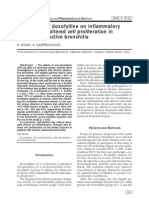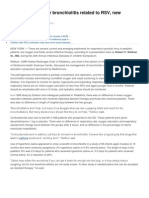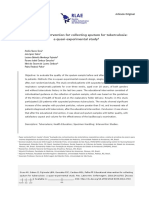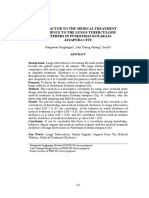The Effectiveness of Sputum PH Analysis in The Prediction of Response To Therapy in Patients With Pulmonary Tuberculosis
Uploaded by
louie john abilaThe Effectiveness of Sputum PH Analysis in The Prediction of Response To Therapy in Patients With Pulmonary Tuberculosis
Uploaded by
louie john abilaThe effectiveness of sputum pH analysis in the prediction of response to therapy in
patients with pulmonary tuberculosis
Abstract
Purpose. The predictive factor of response to antituberculous therapy has not been fully elucidated.
Airway acidity has been thought to be a potential indicator of the bactericidal activity. Therefore,
we hypothesized that monitoring airway acidity by measuring sputum pH could predict response
to therapy.
Methods. A total of 47 patients having newly diagnosed, smear-positive, active pulmonary
tuberculosis were enrolled between October 2011 and March 2014. Sputum samples were serially
analyzed before and after treatment. Eligible patients who initiated a standard 6-month treatment
were monitored for the length of time to sputum smear and culture conversion.
Results. There were 39 patients who completed a 2-month intensive phase of isoniazid, rifampicin,
pyrazinamide, and ethambutol therapy followed by a 4-month continuation phase of isoniazid and
rifampicin. Although factors including age, cavitation, sputum grade, and use of an acid-
suppressant were associated with initial low sputum pH in univariate analysis, multivariate
analysis revealed that only age ≥61 years was a statistically important factor predicting low pH
value (p = 0.005). Further outcome analysis showed that initial low sputum pH before treatment
was the only factor significantly associated with shorter length of time to both sputum smear and
culture conversion (p = 0.034 and 0.019, respectively) independent of the effects of age, sputum
bacterial load, extent of lung lesion, and cavitation. Thus, initial low sputum pH indicated
favorable response to anti-tuberculosis therapy.
Conclusions. Measuring sputum pH is an easy and inexpensive way of predicting response to
standard combination therapy in patients with pulmonary tuberculosis.
Keywords: Antituberculous therapy, Pulmonary tuberculosis, Airway acidity, Sputum pH
Reference: Masuda, M.,i Sato, M., Ishigatsubo,.(2014)The effectiveness of sputum pH analysis in the
prediction of response to therapy in patients with pulmonary tuberculosis.Retrieved from
https://www.ncbi.nlm.nih.gov/pmc/articles/PMC4671190/
You might also like
- Kualitas: Batuk Efektif Metode Lip Breathing TeriiadatNo ratings yetKualitas: Batuk Efektif Metode Lip Breathing Teriiadat6 pages
- Evaluation of Category I of Anti-Tuberculosis Therapy in IntensivNo ratings yetEvaluation of Category I of Anti-Tuberculosis Therapy in Intensiv6 pages
- The Effect of Ginsenoside 4 On InflammatNo ratings yetThe Effect of Ginsenoside 4 On Inflammat6 pages
- 26997926 Hypertonic Saline for the Treatment of Bronchiolitis in Infants and Young Children A Critical Review of the LiteratureNo ratings yet26997926 Hypertonic Saline for the Treatment of Bronchiolitis in Infants and Young Children A Critical Review of the Literature20 pages
- Exhaled Nitric Oxide in The Management of Paediatric AsthmaNo ratings yetExhaled Nitric Oxide in The Management of Paediatric Asthma19 pages
- Goldbart Et Al 2023 Inhaled Nitric Oxide for the Treatment of Acute Bronchiolitis a Multicenter Randomized ControlledNo ratings yetGoldbart Et Al 2023 Inhaled Nitric Oxide for the Treatment of Acute Bronchiolitis a Multicenter Randomized Controlled9 pages
- Association between pathogens detected using quantitative polymerase chain reaction with airway inflammation in COPD at stable state and exacerbations-1No ratings yetAssociation between pathogens detected using quantitative polymerase chain reaction with airway inflammation in COPD at stable state and exacerbations-110 pages
- Effects of Oral Doxofylline On InflammatoryNo ratings yetEffects of Oral Doxofylline On Inflammatory6 pages
- Role of C-Reactive Protein and Procalcitonin in Differentiation of Tuberculosis From Bacterial Community Acquired PneumoniaNo ratings yetRole of C-Reactive Protein and Procalcitonin in Differentiation of Tuberculosis From Bacterial Community Acquired Pneumonia6 pages
- Meta-Analysis of Diagnostic Procedures For Pneumocystis Carinii Pneumonia in HIV-1-infected PatientsNo ratings yetMeta-Analysis of Diagnostic Procedures For Pneumocystis Carinii Pneumonia in HIV-1-infected Patients8 pages
- Diagnostic Accuracy of Xpert MTB/RIF On Bronchoscopy Specimens in Patients With Suspected Pulmonary TuberculosisNo ratings yetDiagnostic Accuracy of Xpert MTB/RIF On Bronchoscopy Specimens in Patients With Suspected Pulmonary Tuberculosis6 pages
- Journal Pre-Proofs: Journal of Chromatography BNo ratings yetJournal Pre-Proofs: Journal of Chromatography B36 pages
- Utility of The Sputum Cytology Applying MGG and Pap Stains in Monitoring Sudanese Patients Complaining of Bronchial AsthmaNo ratings yetUtility of The Sputum Cytology Applying MGG and Pap Stains in Monitoring Sudanese Patients Complaining of Bronchial Asthma6 pages
- Saliva Pepsin Detection and Proton Pump Inhibitor Response in Suspected Laryngopharyngeal Re UxNo ratings yetSaliva Pepsin Detection and Proton Pump Inhibitor Response in Suspected Laryngopharyngeal Re Ux6 pages
- 1996 - M Bonten - AssessmentofgastricacidityinintensivecarepatientsI (Retrieved 2016-12-17)No ratings yet1996 - M Bonten - AssessmentofgastricacidityinintensivecarepatientsI (Retrieved 2016-12-17)6 pages
- Effects of Sucralfate Vs Antacids On Gastric PathogensNo ratings yetEffects of Sucralfate Vs Antacids On Gastric Pathogens7 pages
- Clinical Medicine Insights: Ear, Nose, ThroatNo ratings yetClinical Medicine Insights: Ear, Nose, Throat5 pages
- Bronchial Hyperresponsiveness To Mannitol, Airway Inflammation and Asthma Control Test in Atopic Asthmatic ChildrenNo ratings yetBronchial Hyperresponsiveness To Mannitol, Airway Inflammation and Asthma Control Test in Atopic Asthmatic Children8 pages
- Medicine: Active Case Finding Strategy For Chronic Obstructive Pulmonary Disease With Handheld SpirometryNo ratings yetMedicine: Active Case Finding Strategy For Chronic Obstructive Pulmonary Disease With Handheld Spirometry7 pages
- Research On The Health Benefits of OzoneNo ratings yetResearch On The Health Benefits of Ozone4 pages
- Infection Control & Hospital EpidemiologyNo ratings yetInfection Control & Hospital Epidemiology9 pages
- Impact of Self-Reported Gastroesophageal Reflux Disease in Subjects From Copdgene CohortNo ratings yetImpact of Self-Reported Gastroesophageal Reflux Disease in Subjects From Copdgene Cohort9 pages
- Impact of Immunoglobulin E and Airway Obstruction On BronchiectasisNo ratings yetImpact of Immunoglobulin E and Airway Obstruction On Bronchiectasis7 pages
- Obstructive and Restrictive Diseases Trends and IssuesNo ratings yetObstructive and Restrictive Diseases Trends and Issues2 pages
- Efficacy and Safety of Acupoint Autohemotherapy in PDFNo ratings yetEfficacy and Safety of Acupoint Autohemotherapy in PDF5 pages
- Plasma Heme Oxygenase-1 Levels Distinguish Latent or Successfully Treated Human Tuberculosis From Active DiseaseNo ratings yetPlasma Heme Oxygenase-1 Levels Distinguish Latent or Successfully Treated Human Tuberculosis From Active Disease6 pages
- Impact of Active Smoking On Nasal Functions in Patients With Allergic RhinitisNo ratings yetImpact of Active Smoking On Nasal Functions in Patients With Allergic Rhinitis6 pages
- Moxifloxacin CRP Cytokine - QTC - Acta MedicaNo ratings yetMoxifloxacin CRP Cytokine - QTC - Acta Medica9 pages
- Chronic pharyngitis and the association with pepsin detection and Reflux DiseaseNo ratings yetChronic pharyngitis and the association with pepsin detection and Reflux Disease8 pages
- The Factor To The Medical Treatment Obedience To The Lungs Tuberculosis Sufferers in Puskesmas Kotaraja Jayapura CityNo ratings yetThe Factor To The Medical Treatment Obedience To The Lungs Tuberculosis Sufferers in Puskesmas Kotaraja Jayapura City1 page
- v01 Pneumonia Rapid Testing Case Study - DorNo ratings yetv01 Pneumonia Rapid Testing Case Study - Dor4 pages
- A. Cultural Factors/ethnicity Such As Regard To Elders, Perception of HealthNo ratings yetA. Cultural Factors/ethnicity Such As Regard To Elders, Perception of Health3 pages
- Personal Development Attributes Strength Weakness Plans of ActionNo ratings yetPersonal Development Attributes Strength Weakness Plans of Action2 pages
- Name: Louie John C. Abila BSN-4 Concept Learned Application of The Concept Positive Outcome Challenge Face Action TakenNo ratings yetName: Louie John C. Abila BSN-4 Concept Learned Application of The Concept Positive Outcome Challenge Face Action Taken5 pages
- Louie John C. Abila: BUKIDNON PROVINCIAL HOSPITAL, Maramag, Bukidnon - August 2016 - May 2019No ratings yetLouie John C. Abila: BUKIDNON PROVINCIAL HOSPITAL, Maramag, Bukidnon - August 2016 - May 20193 pages
- A. Cultural Factors/ethnicity Such As Regard To Elders, Perception of HealthNo ratings yetA. Cultural Factors/ethnicity Such As Regard To Elders, Perception of Health6 pages
- Louie John C. Abila Purok 4 Poblacion Valencia City, BukidnonNo ratings yetLouie John C. Abila Purok 4 Poblacion Valencia City, Bukidnon3 pages
- Muyco, Robby Roy G. Old Kibawe, Kibawe BukidnonNo ratings yetMuyco, Robby Roy G. Old Kibawe, Kibawe Bukidnon2 pages
- Factors That Affect Normal Functioning of The Older Persons100% (1)Factors That Affect Normal Functioning of The Older Persons7 pages
- College of Nursing: Republic of The Philippines Central Mindanao University University Town, Musuan, Maramag, BukidnonNo ratings yetCollege of Nursing: Republic of The Philippines Central Mindanao University University Town, Musuan, Maramag, Bukidnon23 pages
- Marvin C. Telin, RN PRC LIC # 0876352 EXPIRATION DATE: 05-03-2019No ratings yetMarvin C. Telin, RN PRC LIC # 0876352 EXPIRATION DATE: 05-03-20191 page
- Shift Work and Employee Fatigue: Implications For Occupational Health NursingNo ratings yetShift Work and Employee Fatigue: Implications For Occupational Health Nursing1 page
- Does Distance Matter? Access To Family Planning Clinics and Adolescent Sexual BehaviorsNo ratings yetDoes Distance Matter? Access To Family Planning Clinics and Adolescent Sexual Behaviors1 page















































































